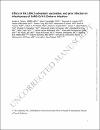Epidemiology of gonorrhoea: systematic review, meta-analyses, and meta-regressions, World Health Organization European Region, 1949 to 2021
| المؤلف | Chidiac, Omar |
| المؤلف | AlMukdad, Sawsan |
| المؤلف | Harfouche, Manale |
| المؤلف | Harding-Esch, Emma |
| المؤلف | Abu-Raddad, Laith J. |
| تاريخ الإتاحة | 2024-04-25T06:20:12Z |
| تاريخ النشر | 2024 |
| اسم المنشور | Eurosurveillance |
| المصدر | Scopus |
| الرقم المعياري الدولي للكتاب | 1025496X |
| الملخص | Background: Epidemiology of Neisseria gonorrhoeae (NG) infection remains inadequately understood. Aim: We aimed to characterise NG epidemiology in Europe. Methods: We used Cochrane and PRISMA guidelines to systematically review, report, synthesise and analyse NG prevalence data from 1949 to 30 September 2021. Random-effects meta-analyses estimated pooled prevalence. Meta-regression analyses investigated associations and sources of heterogeneity. Results:The 844 included publications yielded 1,573 prevalence measures. Pooled prevalence of current urogenital infection was 1.0% (95% CI: 0.7-1.2%) among general populations, 3.2% (95% CI: 1.8-4.8%) among female sex workers, 4.9% (95% CI: 4.2-5.6%) among sexually transmitted infection clinic attendees and 12.1% (95% CI: 8.8-15.8%) among symptomatic men. Among men who have sex with men, pooled prevalence was 0.9% (95% CI: 0.5-1.4%), 5.6% (95% CI: 3.6-8.1%), and 3.8% (95% CI: 2.5-5.4%), respectively, for current urogenital, anorectal or oropharyngeal infection. Current urogenital, anorectal or oropharyngeal infection was 1.45-fold (95% CI: 1.19-1.77%), 2.75-fold (95% CI: 1.89-4.02%) and 2.64-fold (95% CI: 1.77-3.93%) higher among men than women. Current urogenital infection declined 0.97-fold (95% CI: 0.96-0.98%) yearly, but anorectal and oropharyngeal infection increased (1.02-fold; 95% CI: 1.01-1.04% and 1.02-fold; 95% CI: 1.00-1.04%), respectively. Conclusions: Neisseria gonorrhoeae epidemiology in Europe has distinct and contrasting epidemiologies for vaginal sex transmission in heterosexual sex networks vs anal and oral sex transmission in MSM sexual networks. Increased transmission may facilitate drug-resistant strain emergence. Europe is far from achieving the World Health Organization target of 90% incidence reduction by 2030. |
| راعي المشروع | The authors are grateful to Ms. Adona Canlas for administrative support. This publication was made possible by ARG01-0522-230273 from the Qatar Research, Development and Innovation and NPRP grant number 9-040-3-008 from the Qatar National Research Fund (a member of Qatar Foundation). The findings achieved herein are solely the responsibility of the authors. The authors are also grateful for infrastructure support provided by the Biomedical Research Program and the Biostatistics, Epidemiology, and Biomathematics Research Core, both at Weill Cornell Medicine in Qatar. |
| اللغة | en |
| الناشر | European Centre for Disease Prevention and Control (ECDC) |
| الموضوع | anorectal infection Europe gonorrhea human incidence men who have sex with men oropharyngeal infection pharynx disease prevalence rectum disease Review sex worker sexual transmission sexually transmitted disease systematic review urogenital tract infection World Health Organization Chlamydia infection Chlamydia trachomatis female male male homosexuality Neisseria gonorrhoeae sex worker sexual and gender minority Chlamydia Infections Chlamydia trachomatis Female Gonorrhea Homosexuality, Male Humans Male Neisseria gonorrhoeae Prevalence Sex Workers Sexual and Gender Minorities World Health Organization |
| النوع | Article Review |
| رقم العدد | 9 |
| رقم المجلد | 29 |
الملفات في هذه التسجيلة
هذه التسجيلة تظهر في المجموعات التالية
-
الصحة العامة [524 items ]




